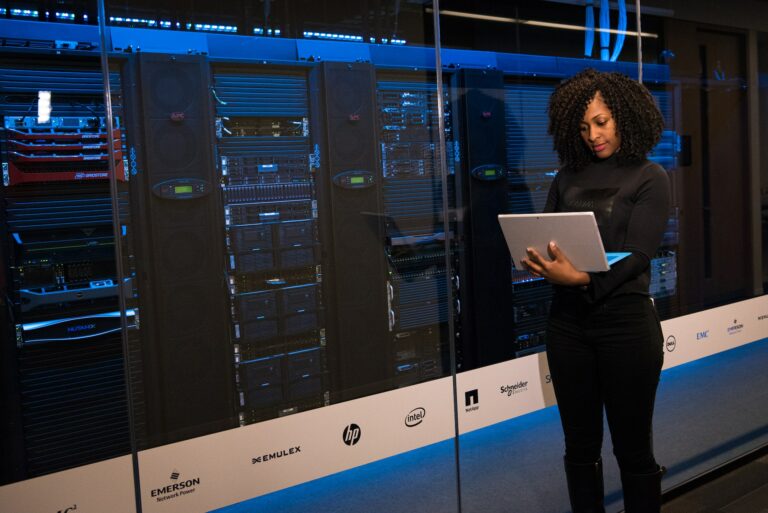A skilled writer with expertise in WordPress and WordPress plugins. With a deep understanding of the technical aspects of website creation and hosting, Sophia’s articles offer valuable insights and tips for readers looking to improve their skills in using WordPress and managing their website’s server hosting.
Ensuring your Magento website’s security and updated functionalities is paramount in the vast and dynamic digital landscape. As technology continues to evolve at lightning speed, it becomes essential for businesses to undertake meticulous website maintenance procedures for their Magento platforms. This article aims to uncover top strategies and expert tips to help you keep your Magento website secure and up-to-date, allowing you to navigate the virtual terrain and safeguard your online presence confidently.
Table of Contents
- 1. Safeguarding Your Online Store: Essential Magento Website Maintenance Practices
- 2. A Secure Foundation: Ensuring Ongoing Protection Through Magento Website Maintenance
- 3. The Constant Battle: Why Regular Security Updates are Vital for Your Magento Website
- 4. Beyond the Basics: Advanced Strategies for Fortifying Your Magento Website Security
- 5. Speed, Stability, and Success: The Importance of Regular Performance Optimization for Your Magento Website
- 6. Staying Ahead of the Curve: Proactive Measures to Combat the Ever-Evolving Threats to Your Magento Website
- 7. Tackling Vulnerabilities Head-On: Best Practices for Patching and Upgrading Your Magento Website
- 8. The Power of Testing: How Comprehensive Quality Assurance Can Safeguard Your Magento Website
- 9. Continuous Improvement: Embracing Ongoing Updates to Enhance User Experience and Website Security
- 10. A Holistic Approach: Creating a Robust Magento Website Maintenance Plan for Total Peace of Mind.
- Our Readers Ask
- Final Thoughts
1. Safeguarding Your Online Store: Essential Magento Website Maintenance Practices
Running an online store can be a thrilling experience, but it also comes with its fair share of challenges. Implementing essential maintenance practices ensures your Magento website’s safety and functionality. Here are some critical tips to safeguard your online store and keep it running smoothly:
Regularly update Magento:
Keeping your Magento platform current is essential. Installing the latest security patches and updates ensures your website is equipped to handle potential threats and vulnerabilities. This will also help you take advantage of new features and improvements provided by Magento.
Perform routine backups:
It’s always better to be safe than sorry! Regularly backing up your Magento website is crucial for unforeseen issues or disasters. By creating backups of your website files and databases, you can quickly restore your website to a previous working state if necessary.
Secure your passwords:
Passwords are the keys to your online store’s security, and as such, they should be solid and unique. Implementing a password policy that includes a mix of uppercase and lowercase letters, numbers, and symbols can significantly enhance the security of your online store.
Monitor for malware:
Malware can wreak havoc on your online store, compromising customer data and damaging your reputation. Implement a robust malware monitoring system that regularly scans your website for potential threats and takes immediate action if any issues are detected.
Optimize website performance:
Slow-loading websites can deter customers and negatively impact sales. Regularly optimizing your Magento website’s performance by compressing images, enabling caching, and removing unnecessary extensions can improve user experience and increase conversion rates.
Stay vigilant against phishing attacks:
Phishing attacks are becoming increasingly sophisticated, with hackers impersonating legitimate websites to steal sensitive information from unsuspecting users. Educate yourself and your staff about phishing techniques and remind customers to be cautious when providing personal information online.
Monitor website analytics:
Monitoring website analytics is crucial to understanding customer behavior, identifying potential issues, and improving overall performance. Utilize tools like Google Analytics to track website metrics such as page views, bounce rates, and conversion rates, and make data-driven decisions to optimize your online store.
By implementing these essential maintenance practices, you can safeguard your Magento online store and provide your customers with a secure and seamless shopping experience. Remember, the safety of your online store should never be overlooked, as it directly impacts your business’s success and credibility.
 2. A Secure Foundation: Ensuring Ongoing Protection Through Magento Website Maintenance
2. A Secure Foundation: Ensuring Ongoing Protection Through Magento Website Maintenance
Your Magento website may be running smoothly, but it’s essential to maintain a strong and secure foundation to ensure ongoing protection and prevent potential issues. Regular Magento website maintenance is crucial in keeping your website safe, optimized, and functioning at its best. Here are some key reasons why investing in ongoing website maintenance for your Magento platform is essential for your business success:
1. Patch and Security Updates:
Technology is constantly evolving, as are the threats that come with it. Regular maintenance ensures that your Magento website has the latest security patches and updates to protect against vulnerabilities. It’s like having a vigilant security guard at your website’s gate, safeguarding it from potential breaches or data theft.
2. Performance Optimization:
Like a well-oiled machine, your Magento website needs regular maintenance to optimize its performance. Through routine checks and optimizations, experts can identify and fix bottlenecks, ensuring your website runs smoothly and efficiently. This way, you provide your users with a seamless, fast, and enjoyable browsing experience, increasing customer satisfaction and conversions.
3. SEO Enhancement:
An adequately maintained Magento website is not just about security and performance; it also significantly improves your search engine rankings. Regular maintenance includes optimizing your website’s structure, meta tags, URLs, and other elements to make it more search engine friendly. This helps boost your visibility, drive more organic traffic to your site, and ultimately increase your business’s online presence.
4. Keeping Up with Magento Updates:
Magento constantly releases updates and new features that enhance its functionality and fix bugs. With ongoing maintenance, you ensure that your website is always running on Magento’s latest and most stable version. This ensures optimal performance and lets you use new features and functionalities to enhance your customer experience and give your business an edge over the competition.
5. Regular Backups:
Accidents happen; when they do, having a recent backup of your Magento website can be a lifesaver. Regular maintenance includes scheduled backups of your website and its data, allowing you to restore it quickly in case of unforeseen events like hacking, data loss, or server failure. This proactive measure helps minimize downtime and ensures your business continues operating smoothly, even in adversity.
Investing in ongoing Magento website maintenance, you prioritize your online business’s security, performance, and overall health. Remember, prevention is always better than cure, and regular maintenance will save you time and money in the long run and contribute to your business growth and success. So, don’t overlook the importance of a secure foundation for your Magento website, and make website maintenance a top priority for your business.
3. The Constant Battle: Why Regular Security Updates are Vital for Your Magento Website
Operating an e-commerce website on Magento comes with immense rewards and substantial security risks that must be mitigated. Regular security updates are critical for protecting your business from cyber threats continuously evolving. Here’s why:
- New vulnerabilities emerge daily – Magento’s popularity makes it a prime target for hackers seeking to exploit weaknesses. Developers work tirelessly to identify and patch vulnerabilities, but your site remains exposed without prompt updates.
- Automated attacks scale rapidly – Botnets and automated hacking tools enable criminals to implement mass attacks quickly through any unpatched opening. Updates are your frontline defense.
- Customer data is at risk – Names, addresses, payment information – exposed data destroys trust and compliance. Security updates prevent breaches that jeopardize sensitive information.
- Downtime is costly – If hacked, your site could face extended outages, lost revenue, and restoration expenses. Updates keep systems safeguarded and online.
- SEO impact is long-lasting – Search engine penalties for malware or compromised sites can devastate organic rankings for months. Updates prevent lasting SEO damage.
- Compliance is mandatory – From PCI DSS to GDPR, regulatory non-compliance due to poor security brings heavy fines. Updates help satisfy legal requirements.
Regularly updating Magento is non-negotiable for protecting your business. Set a recurring schedule, automate processes, and make security updates an unconditional priority. A vigilant, proactive approach is the only way to defend your website against relentless, sophisticated threats. Don’t leave the digital door unlocked.
 4. Beyond the Basics: Advanced Strategies for Fortifying Your Magento Website Security
4. Beyond the Basics: Advanced Strategies for Fortifying Your Magento Website Security
While fundamental security measures like patches and malware scanning provide a crucial foundation, truly robust protection requires an advanced, proactive approach. Here are some key strategies to take Magento website security to the next level:
- Adopt a web application firewall (WAF) – Installing a WAF provides deep, real-time monitoring that identifies and blocks sophisticated injection attacks, bots, and other threats. Manage rules to maximize accurate threat detection.
- Encrypt sensitive data – Implement field-level encryption for any collected customer data like names, addresses, and payment info. Even if hacked, encrypted data is useless to cybercriminals.
- Conduct penetration testing – Schedule recurring simulations of hacking attempts to probe for vulnerabilities beyond automated scans. Address any weaknesses exposed through ethical hacking tests.
- Harden admin interfaces – Limit admin portal access to VPNs or private networks. Enforce multifactor solid authentication and audit logs for any backend changes.
- Isolate sites via containers – Leverage containerization to isolate websites from each other and the underlying operating system, reducing the attack surface. Restrict traffic through rigid controls.
- Automate security processes – Automate as many tasks as possible such as system patching, malware scanning, and compliance audits through orchestration tools to remove reliance on human intervention.
- Plan for incident response – Prepare an incident response plan for containment, investigation, and recovery procedures if a security breach occurs. Practice and refine procedures.
By overlaying robust, layered security measures on top of fundamental Magento website protections, merchants can achieve the highest security and defense against evolving threats targeting e-commerce.
5. Speed, Stability, and Success: The Importance of Regular Performance Optimization for Your Magento Website
Ensuring your Magento website runs optimally is crucial for success in today’s fast-paced digital landscape. Speed, stability, and overall performance are essential for delivering a seamless user experience, maximizing conversions, and improving rankings in search engine results. Regular performance optimization is the key to maintaining a competitive edge and staying ahead of the game.
Regarding speed, a slow-loading website can be highly detrimental to your business. Studies have shown that users are more likely to abandon a website if it takes more than a few seconds to load. By optimizing the loading time of your Magento website, you not only keep visitors engaged but also increase the likelihood of them making a purchase. From leveraging caching techniques to optimizing images and minimizing code, there are various strategies you can implement to enhance the speed of your website.
Stability is another vital aspect that cannot be ignored. A website that crashes or experiences glitches can result in frustrated customers and missed opportunities. Regular performance optimization helps identify and rectify any vulnerabilities or issues affecting your Magento website’s stability. By staying on top of updates, patches, and security measures, you can ensure your website remains stable and secure for visitors and transactions.
In the digital landscape, success is directly tied to the performance of your website. Regular performance optimization for your Magento website guarantees speed, stability, and success. Implementing these optimization techniques will enhance the user experience and improve your website’s performance in search engine rankings, leading to increased visibility and higher conversion rates. Don’t let slow load times or glitches hinder your success – invest in performance optimization and watch your business thrive.
 6. Staying Ahead of the Curve: Proactive Measures to Combat the Ever-Evolving Threats to Your Magento Website
6. Staying Ahead of the Curve: Proactive Measures to Combat the Ever-Evolving Threats to Your Magento Website
In today’s fast-paced digital world, staying ahead of the curve is more important than ever when protecting your Magento website from ever-evolving threats. Implementing proactive measures is crucial to ensuring the security and integrity of your online store. Here are some key strategies to consider:
1. Regularly update Magento and extensions:
Keeping your Magento platform and extensions up-to-date is vital for addressing any vulnerabilities that may be discovered. New security patches and updates are released frequently, so staying on top of these updates is essential in combating potential threats.
2. Utilize a web application firewall (WAF):
A WAF acts as an additional layer of security between your Magento website and the internet. It helps detect and block malicious traffic, including suspicious requests and potentially harmful code. By deploying a WAF, you can significantly reduce the risk of attacks such as SQL injections and cross-site scripting.
3. Implement robust password policies:
Weak passwords are often the gateway for hackers to gain unauthorized access to your Magento website. Encourage your users to create complex passwords that combine uppercase and lowercase letters, numbers, and special characters. Additionally, consider implementing two-factor authentication (2FA) for an extra layer of protection.
It’s crucial to stay one step ahead of the ever-evolving threats that could compromise the security of your Magento website. These proactive measures can minimize the risks and protect your online store from cyber-attacks. Remember, prevention is critical when safeguarding your website and ensuring a secure shopping experience for your customers.
7. Tackling Vulnerabilities Head-On: Best Practices for Patching and Upgrading Your Magento Website
In the ever-evolving world of e-commerce, keeping your Magento website up to date is crucial to stay ahead of vulnerabilities. Patching and upgrading your website regularly ensures the security of sensitive customer data and enhances your website’s performance and functionality. Here are some best practices to tackle vulnerabilities head-on:
1. Stay informed: Keep yourself updated with the latest security alerts and patches released by Magento. Joining forums, following official Magento blogs, and subscribing to security newsletters will help you avoid potential threats.
2. Create a testing environment: Before applying any patches or upgrades to your live website, testing them in a controlled environment is essential. Set up a development or staging site where you can try the changes without affecting your live site’s performance or customer experience. This will help identify any potential issues or conflicts before going live. Remember to back up your website before performing any updates or patches.
3. Prioritize critical patches: Not all patches are created equal. Some patches address critical vulnerabilities that could expose your website and customer data to hackers. It is essential to prioritize and apply these critical patches immediately. Magento provides a Security Scan tool that can help you identify vulnerabilities and prioritize their patching.
4. Upgrade to the latest version: Upgrading to the newest version of Magento ensures that you have access to the latest security features and bug fixes. Additionally, it offers improved performance and new features that can enhance your customers’ experience. However, before upgrading, it is crucial to thoroughly check the compatibility of installed extensions or customizations to avoid conflicts.
Taking a proactive approach to patching and upgrading your Magento website significantly reduces the risk of security breaches and improves your online presence. Following these best practices ensures that your website remains secure, up-to-date, and fully optimized for a seamless customer experience. Remember, staying vigilant and regularly monitoring your website’s security is critical to safeguarding your online business.
 8. The Power of Testing: How Comprehensive Quality Assurance Can Safeguard Your Magento Website
8. The Power of Testing: How Comprehensive Quality Assurance Can Safeguard Your Magento Website
One of the most overlooked aspects of managing a Magento website is the power of testing. Comprehensive quality assurance can safeguard your website from potential issues and ensure a seamless user experience for your customers.
First and foremost, testing allows you to identify any bugs or glitches that may arise during the development process. By thoroughly testing your website, you can quickly catch and rectify these issues before they become significant problems. This not only saves you valuable time and resources but also enhances the overall reliability of your website.
Moreover, testing enables you to optimize the performance and functionality of your Magento website. You can fine-tune various aspects through rigorous testing, such as page load speed, responsiveness, and compatibility across different devices and browsers. Doing so ensures your website looks great and provides an exceptional user experience. Additionally, testing allows you to verify that your website is fully functional and that all features, such as shopping carts, payment gateways, and search functionality, work seamlessly.
Investing time and effort in comprehensive quality assurance for your Magento website is crucial for its success. Testing helps you identify and fix issues, improve performance, and ensure an outstanding user experience. By making testing an integral part of your development process, you safeguard your Magento website from pitfalls and set a solid foundation for growth and success.
9. Continuous Improvement: Embracing Ongoing Updates to Enhance User Experience and Website Security
Continuous improvement is fundamental to ensuring a top-notch user experience and robust website security. By embracing ongoing updates, you can stay ahead of the curve and ensure your website remains optimized and secure. Here are some key ways to implement continuous improvement:
Regularly review and update your website design: Trends and user preferences can change rapidly in the fast-paced digital world. By keeping a pulse on the latest design trends and continuously updating your website’s design, you can ensure that it remains visually appealing and user-friendly. This includes incorporating responsive design elements, eye-catching colors and optimizing page loading speed.
Stay updated with the latest security measures: Website security is paramount to protect your user’s sensitive data and maintain their trust. Regularly updating your website’s security measures is essential to safeguard against potential cyber threats. This includes implementing SSL certificates, robust firewalls, and using secure passwords for user logins.
Regularly test and optimize website performance: Regularly evaluating and optimizing your website’s performance is crucial to ensure a smooth user experience. Conduct tests to identify any performance bottlenecks or usability issues. Optimize page load times, minimize image sizes, and regularly review and update your website’s content to keep it fresh and relevant.
Listen to user feedback: Your users are the best source of information on improving your website. Collect and analyze user feedback through surveys, feedback forms, or social media listening tools. Implement any suggestions or necessary changes based on this feedback to constantly enhance the user experience.
Continuously monitor and update SEO strategies: SEO is vital for driving organic traffic to your website. Stay updated with the latest search engine algorithms and adjust your SEO strategies accordingly. Regularly review and optimize your website’s meta tags, headers, and content to improve search engine rankings and increase visibility.
By consistently embracing ongoing updates and improvements, you can enhance the user experience, boost website security, and stay ahead of your competition. Don’t underestimate continuous improvement’s power to keep your website relevant, engaging, and secure!
 10. A Holistic Approach: Creating a Robust Magento Website Maintenance Plan for Total Peace of Mind
10. A Holistic Approach: Creating a Robust Magento Website Maintenance Plan for Total Peace of Mind
Congratulations, you’ve built a powerful Magento website. Now, it’s time to ensure its longevity and smooth functioning. A holistic approach to website maintenance is essential for achieving total peace of mind. By following a robust maintenance plan, you can avoid unexpected downtime, security vulnerabilities, and other potential issues that may arise.
To begin with, regular backups are a crucial component of any maintenance plan. Backing up your Magento website ensures you have a recent copy of your data and files stored securely. In the event of a mishap, whether it be a server crash, accidental deletion, or a malicious attack, you can quickly restore your website to its previous state. Consider implementing an automated backup system so you don’t have to worry about manually performing backups. This way, you can focus on growing your business without the fear of losing valuable information.
Additionally, keeping your Magento installation up to date is vital for website security and performance. Regularly updating your Magento platform, themes, and extensions helps to patch any identified vulnerabilities and ensure compatibility with new features and technologies. This not only keeps your website secure but also improves its overall functionality. To prevent any undesirable conflicts or errors, thoroughly test the updates on a staging environment before applying them to the live website.
Incorporating these key elements into your Magento website maintenance plan will give you the peace of mind to focus on your business growth. Through regular backups and up-to-date software, you can protect your website from potential risks, ensuring its smooth operation and the satisfaction of your customers. With a holistic approach in place, you can confidently move forward, knowing that your Magento website is well-maintained and secure.
Our Readers Ask
Q: Why is it important to regularly maintain a Magento website?
A: Regular maintenance is crucial to keeping your Magento website secure and up-to-date. Ignoring maintenance tasks can leave your website vulnerable to security breaches and performance issues.
Q: What are some critical steps to ensure Magento website maintenance?
A: Keeping your Magento website in optimal condition involves several crucial steps. These include regularly updating the core files and extensions, managing and optimizing the database, implementing strong security measures, and monitoring website performance.
Q: How often should I update the core files and extensions?
A: It is recommended to update the core files and extensions as soon as new updates or security patches are released. By staying on top of these updates, you ensure your website remains current with the latest features, bug fixes, and security enhancements.
Q: What steps can I take to optimize my Magento database?
A: Database optimization plays a significant role in maintaining website performance. Regularly cleaning up unnecessary data, optimizing tables, and configuring caching mechanisms are effective practices to keep your database running smoothly and improve overall website speed.
Q: How can I strengthen the security of my Magento website?
A: To enhance your Magento website’s security, it is essential to implement a multi-layered security strategy. This includes regularly updating passwords, enabling two-factor authentication, securing your server environment, installing a reliable firewall, and using secure payment gateways.
Q: How can I monitor the performance of my Magento website?
A: Monitoring your website’s performance lets you promptly identify and address any issues. Utilizing tools like Google Analytics, PageSpeed Insights, and server monitoring software can help you track page load speed, user engagement, and server uptime metrics.
Q: Is it necessary to hire professionals for Magento website maintenance?
A: While basic maintenance tasks can be handled by website owners, investing in professional Magento maintenance services can ensure comprehensive and efficient upkeep. Professionals have the expertise to address complex issues, effectively manage updates, and provide ongoing support to keep your website at its best.
Q: What are the consequences of neglecting Magento website maintenance?
A: Neglecting Magento website maintenance invites numerous risks, including security breaches, compromised customer data, decreased website performance, increased vulnerability to malware, and loss of consumer trust. Regular maintenance is essential to avoid these potentially damaging consequences.
Q: Is there any ongoing maintenance necessary after implementing initial website maintenance practices?
A: Absolutely! Maintenance should be an ongoing process for your Magento website. As technology evolves, new security threats emerge, and the needs of your business change, it is crucial to adapt and consistently update and optimize your website to ensure its continued security and success.
Final Thoughts
Maintaining a Magento website should not be taken lightly. It requires dedication, diligence, and a deep understanding of the platform’s intricacies. However, following the steps outlined in this article, you can ensure that your Magento website remains secure and up-to-date, providing a seamless and safe experience for you and your customers.
Remember, security is not a one-time task but an ongoing process. Regularly monitoring your website for vulnerabilities, periodically updating your Magento installation, and implementing strong security measures will significantly reduce the risk of a breach.
As a Magento website owner, you hold the power to safeguard your business and create a safe environment for your customers to engage with your products and services. Don’t let complacency or ignorance compromise the trust that you have worked so hard to earn.
By investing time and effort into keeping your Magento website secure and updated, you protect your business and stay one step ahead of cybercriminals constantly looking for vulnerabilities to exploit.
So, take action today and maintain a secure and updated Magento website. Your efforts will pay off in the long run, ensuring a thriving online presence and a trusted brand image for years.
A skilled writer with expertise in WordPress and WordPress plugins. With a deep understanding of the technical aspects of website creation and hosting, Sophia’s articles offer valuable insights and tips for readers looking to improve their skills in using WordPress and managing their website’s server hosting.







 2. A Secure Foundation: Ensuring Ongoing Protection Through Magento Website Maintenance
2. A Secure Foundation: Ensuring Ongoing Protection Through Magento Website Maintenance 4. Beyond the Basics: Advanced Strategies for Fortifying Your Magento Website Security
4. Beyond the Basics: Advanced Strategies for Fortifying Your Magento Website Security 6. Staying Ahead of the Curve: Proactive Measures to Combat the Ever-Evolving Threats to Your Magento Website
6. Staying Ahead of the Curve: Proactive Measures to Combat the Ever-Evolving Threats to Your Magento Website 8. The Power of Testing: How Comprehensive Quality Assurance Can Safeguard Your Magento Website
8. The Power of Testing: How Comprehensive Quality Assurance Can Safeguard Your Magento Website 10. A Holistic Approach: Creating a Robust Magento Website Maintenance Plan for Total Peace of Mind
10. A Holistic Approach: Creating a Robust Magento Website Maintenance Plan for Total Peace of Mind




